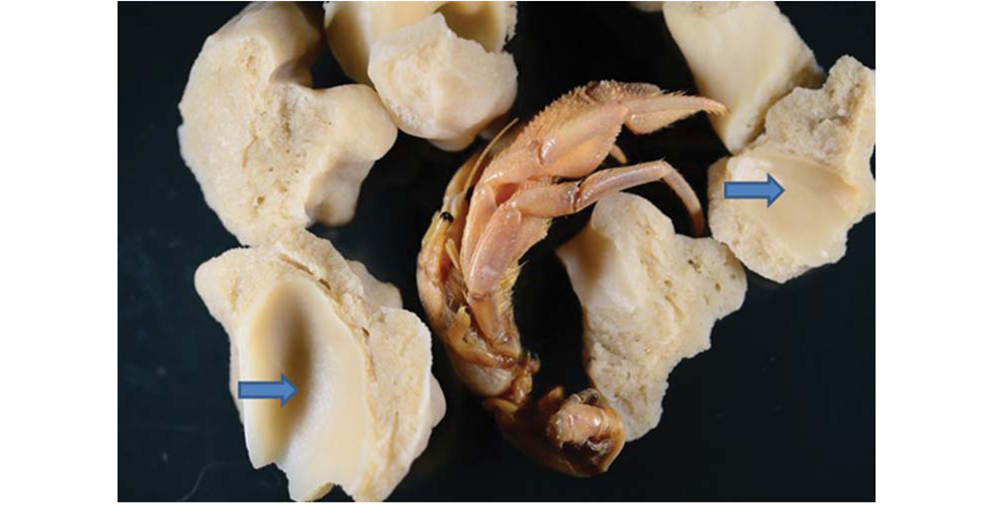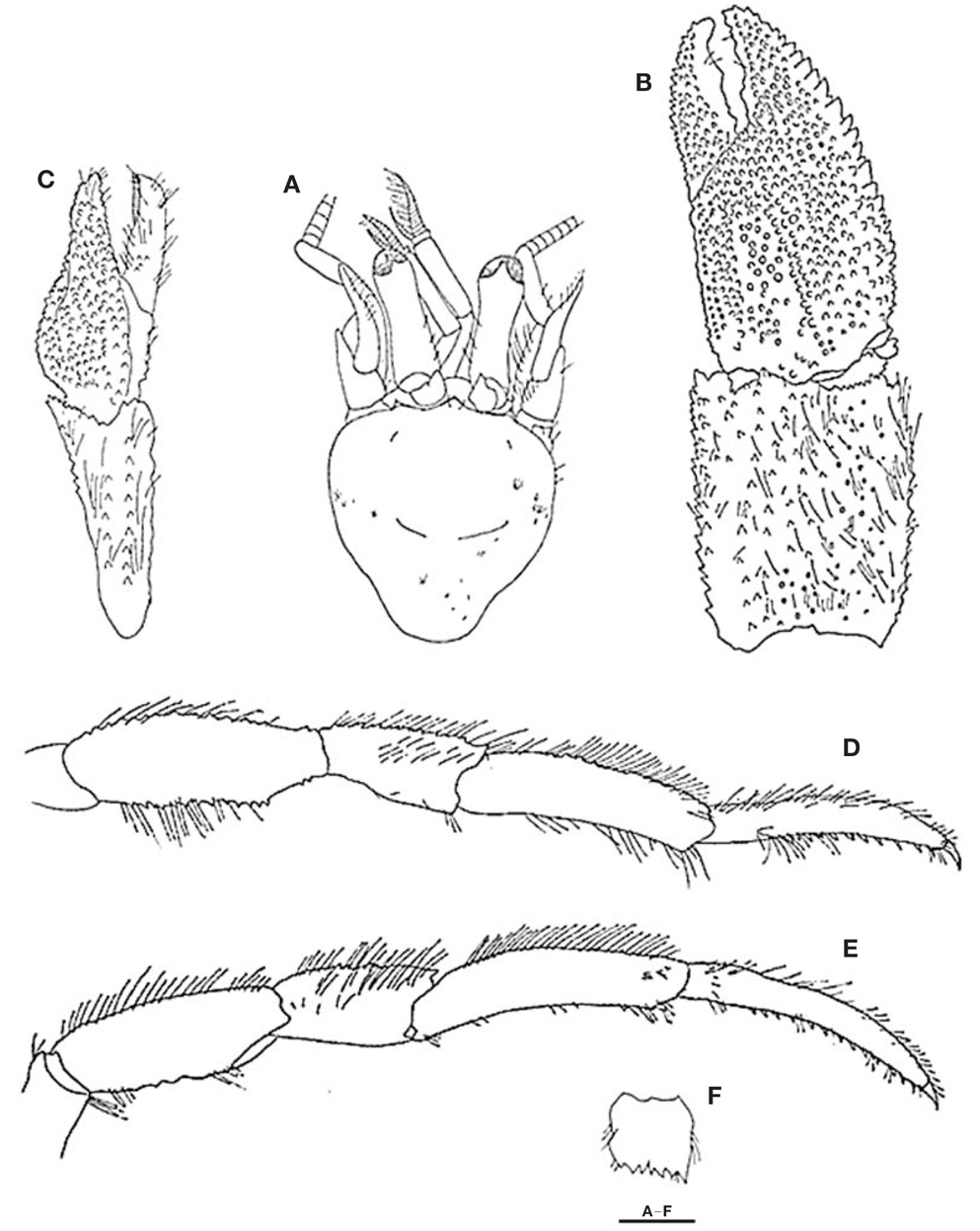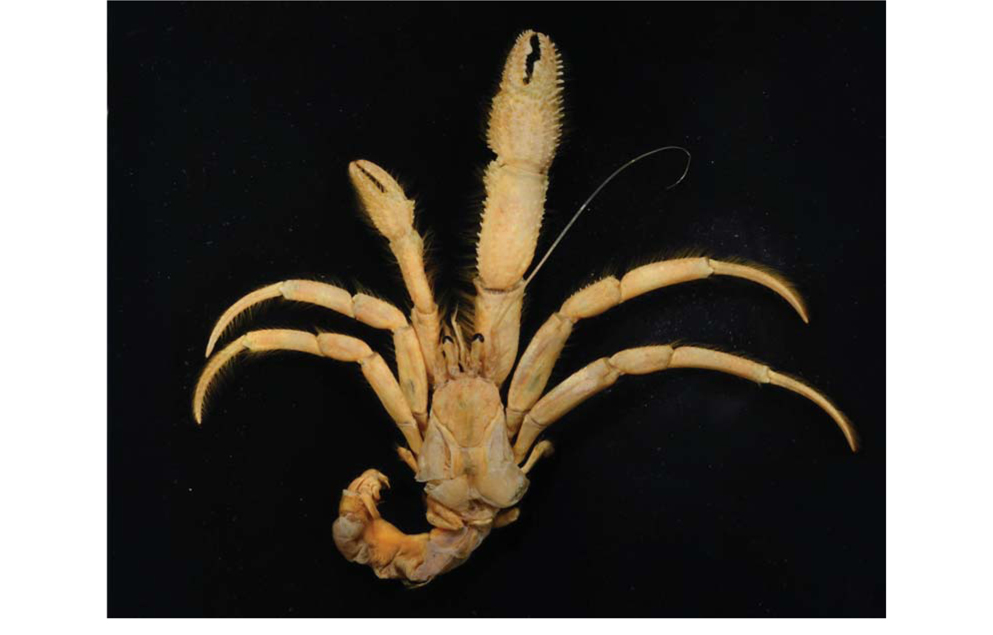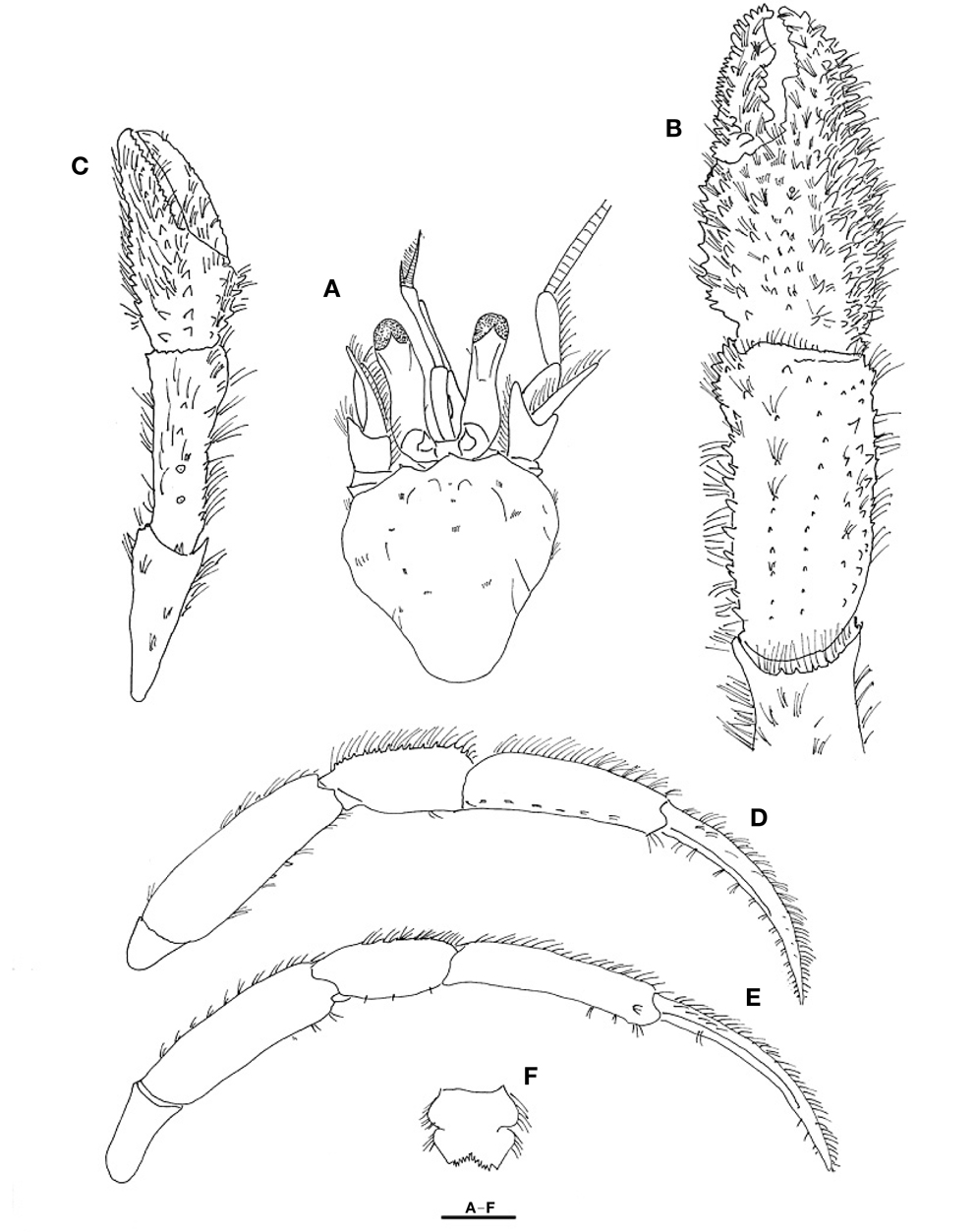



The genus
Most species of the genus
The specimens examined in this study were preserved in 70% ethanol. Characters were observed using a digital slide caliper, Mitutoyo CD6CSX (Mitutoyo, Kawasaki, Japan), to the nearest 0.01 mm. All drawings were made with a camera lucida on a Nikon SMZ800 (Nikon, Tokyo, Japan). Images were taken by a digital camera D200 (Nikon) and were developed with Helicon Focus software. The abbreviation ‘sl’ indicates shield length measured from the tip of the rostrum to the midpoint of the posterior margin of the shield. The terminology is after McLaughlin et al. (2007). The examined specimens in this study are deposited in the Marine Arthropod Depository Bank of Korea, Seoul National University (MADBK).
Order Decapoda Latreille, 1803Superfamily Paguroidea Latreille, 1802Family Paguridae Latreille, 1802Genus Pagurus Fabricius, 1775
1*Pagurus undosus (Benedict, 1892) (Figs. 1, 2)Eupagurus (Trigonochirus) undosus Benedict, 1892: 18 (type locality: Bering Sea).Pagurus undosus: Rathbun, 1904: 159, fig. 6; Makarov, 1962: 182; Komai, 1994: 24-27, fig. 1.
Material examined. 3♂♂ (sl 3.34-6.90 mm), 1♀ (sl 2.96 mm), 1 ovig. ♀ (sl 4.90 mm), Korea: Gangwon-do, Samchuck-si, Port Imwon, 28 Jan 2002, by commercial bottom trawl; 1♂ (sl 7.20 mm), 2 ovig. ♀ (sl 4.45, 4.50 mm), Gangwon-do, Samchuck-si, Port Jangho, 26 Feb 2003; 1♂ (sl 6.70 mm), 2♀♀ (sl 5.69, 5.76 mm), Gangwon-do, Gosunggun, Port Oholi, 17 Jun 2012, by commercial shrimp trap, coll., Park JH.
Description. Shield (Fig. 2A) almost as broad as long; rostrum short, triangular. Lateral projection triangular, bearing tiny submarginal spine. Ocular peduncles 0.7-0.8 times as long as shield; corneas somewhat dilated. Antennular peduncles exceeding ocular peduncles by 0.6 length of ultimate segment. Antennal peduncles slightly overreaching distal margins of corneas.
Right cheliped (Fig. 2B) larger than left, 4-5 times as long as shield; chela 2.3-2.5 times as long as broad. Dactylus almost same length of palm measured along mesial margin, slightly upturned, depressed distally; dorsomesial margin with closely located small tubercles, cutting edge with row of calcareous teeth, terminating in small corneous claw. Palm with closely located small tubercles, slightly elevated medially, with broad ridge formed by deep depressions mesial and lateral to midline; dorsolateral margin sharply sloping, with 2 rows of strong tubercles. Carpus 0.8-0.9 times as long as chela, strongly inflated ventrally; dorsal surface with numerous scattered tubercles and tufts of setae; dorsolateral and dorsomesial margins each with row of strong spines; distal margin denticulate. Merus with 1 strong tubercle and tufts of long setae on ventral surface. Left cheliped (Fig. 2C) reaching to middle of palm of right chela. Dactylus longer than palm, all surfaces bearing tufts of setae. Palm with dorsolateral surface expanded, with irregular row of small tubercles; dorsal margin with small tubercles; mesial margin elevated into strong ridge with row of strong spines. Carpus slightly longer than chela, with tufts of setae; dorsal surface slightly flattened, with rows of strong spines. Ventral margin of merus covered with tufts of long setae.
Second and third pereopods slender and long, with tufts of setae. Second pereopod (Fig. 2D) as long as right cheliped. Dactylus 1.2 times as long as propodus, somewhat twisted; dorsal margin with row of small spines; ventral margin with 1 row of strong spines. Dorsal margin of propodus armed with 2 rows of small spines; dorsal and ventral surfaces with long setae. Dorsal margin of carpus covered with 8-13 strong spines and tufts of long setae. Dorsal margin of merus covered with 2 rows of small spines; ventral margin with 1 row of strong spines.
Third pereopod (Fig. 2E) similar to second pereopod. Spines of dorsal margin of dactylus stronger than those of second pereopod. Dorsoproximal margin of carpus bearing 1 strong spine. Spines on dorsal margins of carpus and merus weaker than those of second pereopod. Abdomen twisted, with 3 unpaired pleopods.
Telson (Fig. 2F) with posterior lobes asymmetrical, separated by narrow median cleft, left lobe larger than right one; each terminal margin with 3-4 strong spines and some setae. Coloration in life. Whole body orange generally (Fig. 1). Spines on capi and meri of chelipeds reddish brown. Second and third pereopods with reddish brown bands unclearly delimited on white or orange background.
Remarks. This species is first recorded from Korean waters. It was recorded from the Bering Sea (Benedict, 1892), Sea of Okhotsk (Rathbun, 1904) and from the waters of northen Japan (Komai, 1994). The present study extends the range of geographical distribution of this species southwardly. The specimens examined show the following different characteristics when compared with the description by Komai (1994): dorsal surface of carpus of right cheliped with scattered spines, with a row of moderately strong spines; dorsal surfaces of dactyli of second and third pereopods each with with a row of strong spines; dorsoproximal margin of carpus of third pereopod with a spine; telson with few short setae. These characteristics were not mentioned by Komai (1994). However, other characteristics are similar to those of his description.
The specimen used in this description was found living in the sponge. The body of this specimen fits well within the hole of the sponge (see arrows in Fig. 1). Makarov (1962) has previously reported that this species sometimes inhabits the sponge. It is similar to that observed in
Habitat. Most specimens were found in the gastropod shell, but the specimen used in the description was living in the sponge.
Distribution. Bering Sea; Chukchi Sea; Sea of Okhotsk; northern Japan; East Sea, Korea (present study).
1*Pagurus parvispina Komai, 1997 (Figs. 3, 4)Pagurus rathbuni: Igarashi, 1970: 6, Pl. 4, fig. 13. Not Pagurus rathbuni (Benedict, 1892).Pagurus parvispina Komai, 1997: 113-122, figs. 1-4 (type locality: off Esan, southern Hokkaido); Marin et al., 2012: 275-276, fig. 1.
Material examined. 1♂ (sl 12.69 mm), Korea: Geungsangbuk-do, Pohang-si, Port Yangpo, 22 Apr 2011, by commercial fish trap, coll., Jung J.
Description. Shield (Fig. 4A) longer than broad; rostrum broad, triangular. Lateral projection triangular, bearing produced spine. Ocular peduncles 0.6 times as long as shield; corneas somewhat dilated. Antennular peduncles exceeding ocular peduncles by 0.6 length of ultimate segment; flagellum 6 times as long as shield.
Right cheliped (Fig. 4B) larger than left, 6 times as long as shield. Chela 2.3 times as long as broad. Dactylus almost same length of palm measured along mesial margin, surface with long tufts of setae; dorsal margin with closely located large spines facing toward palm; dorsomesial surface with 2 rows of spines; cutting edge with row of calcareous teeth, terminating in corneous claw. Palm covered with long tufts of setae and large spines; dorsal margin convex, covered with 6 rows of strong spines; dorsomesial margin with 2 rows of strong spines; dorsolateral surface with 1 row of strong spine. Carpus 0.8 times as long as chela, strongly inflated ventrally; surface margin with 5 rows of strong tubercles and tufts of long setae, dorsomesial margin with 1 rows of strong spines; distal margin denticulate; dorsolateral margin with row of strong tubercles. Merus covered with long tufts of setae.
Left cheliped (Fig. 4C) reaching to distal end of carpus of right chela. Dactylus longer than palm, all surfaces bearing tufts of setae; dorsomesial margin with row of small tubercles. Dorsolateral surface of palm with irregular rows of small spines; dorsomesial margin elevated into weak ridge, armed with row of strong spines. Carpus slightly shorter than chela; dorsal surface slightly flattened; dorsomesial margin with row of strong spines. Merus with ventral margin bearing tufts of long setae and 2 rows of strong spines.
Second and third pereopods slender and long. Second pereopod (Fig. 4D) as long as right cheliped. Dactylus 1.2 times as long as propodus, somewhat twisted; dorsal margin with dense long setae; ventral margin with tufts of long setae and strong spines arranged in single row. Dorsal margin of propodus with row of small tubercles and tuft of long setae; dorsal and ventral surfaces with long tufts of setae. Dorsal margin of carpus covered by spines and tufts of long setae. Merus with tufts of long setae; ventral margin with row of spines.
Third pereopod (Fig. 4E) similar to second pereopod; spines on dorsal margin of carpus; ventral margin of merus weaker than those of second pereopod.
Abdomen twisted, with 3 unpaired pleopods in male.
Telson (Fig. 4F) with posterior lobes asymmetrical, separated by narrow median cleft, left lobe larger than right one; each terminal margins with 7 strong spines; lateral margins with setae.
Remarks. This species is first reported from Korean waters. It is distributed in northern and northeastern Japan (Komai, 1997) and Bostok Bay (Marin et al., 2012). The present study extends the range of geographical distribution of this species southwardly. The present specimens show one different characteristic when compared with the original description by Komai (1997). Spines on dorsal surface of dactylus of right cheliped are elongated and bent to the direction of the palm, and are arranged compactly, but those of Komai’s (1997) specimen are not. Other characteristics are almost identical, and so, such difference is regarded as individual variation or traces of damage.
Habitat. Living in the gastropod shell.
Distribution. Vostok Bay, Russia; northern and northeastern Japan; East Sea, Korea (present study).




